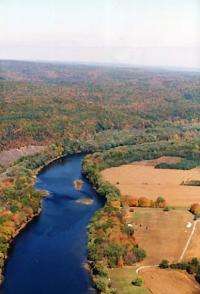European settlers not the first to alter american landscape

One of the great American myths claims that before Europeans colonists settled in North America, Native Americans existed in total harmony with nature, surviving on the renewable bounty that the continent's natural environment provided and altering little of the surrounding landscapes. They were America’s first environmentalists and the land they lived in remained unspoiled. But that is not entirely true.
Research by scientists at Baylor University, the Smithsonian Institution, and Temple University has found that the Native Americans who lived in the Delaware Valley, the river valley that separates New Jersey from Pennsylvania, dramatically altered its terrain with their farming. They cleared forests and increased the number of floods.
“From the period 1000-1600 A.D., a few hundred years before European colonization, there was this episode of strong, more frequent flooding that coincides with increase in prehistoric land use,” said Gary Stinchcomb, a doctoral student at Baylor and lead author of the study. “We also find increasing [numbers of] maize kernels and we also find more grasses at the site.”
While the alteration in the landscape was hardly in the league with what the colonists did later -- the pre-colonial population was never very large -- the impact was not insignificant and the alterations continued until the Native Americans left the valley in the early 18th century.
Another myth is that the Eastern part of North America, particularly the mid-Atlantic states and the Northeast, were completely forested. That is also likely not true as the Native Americans had to clear the forest to make way for their crops, and corn was grown almost everywhere along the East Coast.
The paper appears on-line in the journal Geology.
The Native Americans in the area were called Delawares by Europeans, called them-selves Lenni Lenape and are now virtually extinct. They moved out of the area before the American Revolution, leaving behind only place names. The few remaining Le-nape have gone to Canada or been absorbed into the Cherokee Nation in Oklahoma, and the last native speaker died decades ago.
Stinchcomb said the researchers analyzed a range of material as part of their study, including: maize kernels deposited by the floods at archeological sites in the area, carbon dating, geochemical signatures of carbon, artifacts and bodies called phytoliths or plant stones which are small silica bodies found in many plants, especially grass and maize. The phytoliths give researchers a picture of what types of plants were in the area.
The researchers found that during the period archeologists call the Late Woodland, the 500 or so years before the European colonization, the number of agricultural sites in the valley grew dramatically as the Native Americans greatly increased land use.
While a population increase could account for some of the expansion, a more likely scenario is increased agriculture.
According to Dean Snow, professor of archeological anthropology at Pennsylvania State University, the Lenape depended on deer hides for clothing, which motivated hunters to follow the wanderings of deer throughout the valley. They always returned to their villages, where the crops were being raised. If the deer moved, the Lenape and their farms and villages moved with them.
The researchers also looked at sedimentation rates or flooding in the river valley and flood plain. They found an increase in the same time period, Stinchcomb said, and that appeared to be true all along the river valley.
Correlation does not equal causation, but Stinchcomb said that “this data suggests that as Native Americans practiced more intensive farming, they increased the magnitude and frequency of flooding in the river valleys.”
That the Lenape affected the environment was known before -- Native Americans did not always act as good stewards of the land as asserted by mythology -- but the discovery of the increased flooding was new, Snow said.
To plant their crops, the Lenape had to chop down trees, and anecdotal evidence supports that conclusion. Early colonists reported finding huge tracts of land in the river valleys that had apparently been cleared. They, of course, then proceeded to clear the rest.
The finding also helps resolve an old debate among anthropologists -- now somewhat muted -- over just how agricultural the Lenape were. According to this finding, agriculture was a major factor in their lives, Snow said.
The impact of the Lenape’s farming however has a broader, semantic result.
“Our streams prior to European colonization are not, by definition, natural. They probably have been tampered with,” Stinchcomb said.
More information: Pre-colonial (A.D. 1100–1600) sedimentation related to prehistoric maize agriculture and climate change in eastern North America, doi:10.1130/G31596.1
Provided by Inside Science News Service

















